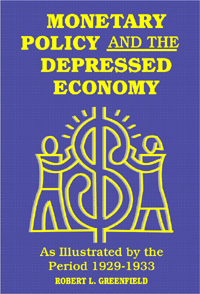Subtotal: 0.0
Monetary Policy and the Depressed Economy
₹2072
Monetary Policy and the Depressed Economy
Strangulation, suffocation are not words too strong to express the agony of the industrial body when embraced in the fast-tightening folds of a contracting money supply.
The easier way of learning for the pupil is that which proceeds by concrete illustrations and by the discussion of actual cases.
Francis A. Walker, 1891
Macroeconomic problems have a chance to develop and then inten¬sify, because what one person produces doesnt exchange directly for what other people produce. Goods and services exchange for goods and services indirectly, through the intermediary of money. A shortage of money obstructs the process of exchange and, by ob¬structing the process of exchange, obstructs the production of things to be exchanged. A close look at the depressed economy reveals it as an economy hamstrung by a shortage of money.
But what causes the shortage of money in the first place? Doesnt monetary policy have the job of keeping any such shortage from developing? Well, sometimes, the monetary authorities will permit their bank-supervisory function to dominate their money-supply¬management function. Or theyll forget that their own rules and regulations constrain the quantity of bank money when people shift from an asset that doesnt require a cash reserve to an asset that does. Theyll at times become preoccupied with foreign-exchange rates as a gauge of monetary policy, or with interest rates, or with the stock market. Budget balancing may so come to dominate the thinking of the Treasury that fiscal policy will contribute to a short¬age of money. Whatever its cause, a shortage of money obstructs the exchange of goods and services for other goods and services. Production and employment therefore suffer, even as badly, per¬haps, as they did during the 1930s.
Especially these days, the possibility of a new Great Depression seems less far fetched than it did even a few years ago. Unless we understand what caused the last Great Depression, however, well stand little chance of preventing a new Great Depression. Good reason, then, for adopting the period 1929-1933 to illustrate the damage that restrictive monetary policy can do. Focusing on that period conveys a sense of studying mllcroeconomics for a purpose, not just in the abstract but concretely, as it applies to a period that changed things forever.
Some of the economists who will consider this book for classroom use call themselves Old Monetarists others call themselves New Keynesians. Some teach macroeconomics or monetary and fiscal policy others teach money and banking or American economic history. Whatever they call themselves, whatever course they happen to teach, they agree that, if asked to do too much, markets can fail to clear. When markets dont clear, people and machines wind up unemployed-involuntarily unemployed.
Customarily, a preface concludes with an acknowledgement of the authors indebtedness. Im indebted heavily, especially to Leland B. Yeager, whose influence nearly everyone of these pages reflects, but also to Wadsworths reviewers: Anna J. Schwartz, National Bureau of Economic Research, Hugh Rockoff, Rutgers University and Christine Amsler, Michigan State University.
? President, American Economic Association, 1886-1892, and president, MIT, (1881-1897).
CHAPTER 1 DEPRESSION THE MONETARY DIAGNOSIS
The Medium of Exchange
But Who Goes First?
A Dollar is a Dollar, and a Dime is a Dime
Other Possibilities
MONEY AND THE GREAT DEPRESSION
The Data
Scrip
The Crash (And Other Diagnoses)
CHAPTER 2 BANKS
BANK MONEYAND MONETARY POLICY
The Bookkeepers Pen
A Bank on Every Comer
The Credit Crunch
High-Powered Money
Buying and Selling Financial Assets
THE COLLAPSE OF THE DEPRESSION-ERA BANKING SYSTEM
Monetary Policy, 1929-1930
Some Horne Economics of the Banking Crises
Depression Again
CHAPTER 3 THE TREASURY
FINANCING GOVERNMENT SPENDING
Mechanics
The Governinents Budget Constraint
Who Foots the Bill?
Endorsements
Who Should Pay the Taxes Called Deficits?
THE TREASURY DURING THE GREAT DEPRESSION
The Logic of the Unbalanced Budget
Depression-Era Budgets and Their Effects on the
Money Supply
CHAPTER 4 THE GLOBAL ECONOMY
THE BALANCE OF PAYMENTS
Minding Your Own Business
Imposition Through Official Intervention
A Price Test to Eliminate the Guesswork?
A Balance-of-Payments Deficit as a Subsidy from Abroad
EXCHANGE RATES
All Quiet on the Dollar Front
The Managed Float, or Nationalized Gambling
Nontradeables
Capital Flows
THE WORLD IN DEPRESSION
Gold Flows
Gold Policy
The Canadian Gold Standard
Free Gold
Bullionism
The Silver Shield
CHAPTER 5 INTEREST RATES
MONEY, NOT CREDIT
Whos Counting
Self-Denial
How Preoccupation with Interest Rates Can Go Wrong
The Discount Rate
Experimental Monetarism?
PREOCCUPATION WITH INTEREST RATES DURING THE 1930s
Who Was Benjamin Strong?
Legislative Ambiguity
The Stock-Market Boom
CHAPTER 6 ANTICIPATION OF THE GREAT DEPRESSION AND OF ITS RECURRENCE
INDEX


Please Login To Write A Review
Login